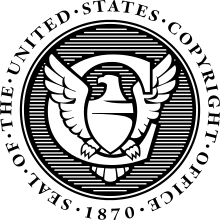Visual Artists Rights Act
The Visual Artists Rights Act of 1990 (VARA), 17 U.S.C. § 106A, is a United States law granting certain rights to artists.
VARA was the first federal copyright legislation to grant protection to moral rights. Under VARA, works of art that meet certain requirements afford their authors additional rights in the works, regardless of any subsequent physical ownership of the work itself, or regardless of who holds the copyright to the work. For instance, a painter may insist on proper attribution of his painting, and in some instances may sue the owner of the physical painting for destroying the painting even if the owner of the painting lawfully owned it.[1]
Although federal law had not acknowledged moral rights before this act, some state legislatures and judicial decisions created limited moral-rights protection. The Berne Convention required the protection of these rights by signatory states, and it was in response that the U.S. Congress passed the VARA.
Exclusive rights under VARA
VARA exclusively grants authors of works that fall under the protection of the Act the following rights
- right to claim authorship
- right to prevent the use of one's name on any work the author did not create
- right to prevent use of one's name on any work that has been distorted, mutilated, or modified in a way that would be prejudicial to the author's honor or reputation
- right to prevent distortion, mutilation, or modification that would prejudice the author's honor or reputation
Additionally, authors of works of "recognized stature" may prohibit intentional or grossly negligent destruction of a work. Exceptions to VARA require a waiver from the author in writing. To date, "recognized stature" has managed to elude a precise definition. VARA allows authors to waive their rights, something generally not permitted in France and many European countries whose laws were the originators of the moral rights of artists concept.[2]
In most instances, the rights granted under VARA persist for the life of the author (or the last surviving author, for creators of joint works).
Covered works
VARA provides its protection only to paintings, drawings, prints, sculptures, still photographic images produced for exhibition only, and existing in single copies or in limited editions of 200 or fewer copies, signed and numbered by the artist. The requirements for protection do not implicate aesthetic taste or value.
Application and effect
VARA's application is limited to visual works that fall within a narrowly defined category. However, for works that do fall within the category of protected works, VARA imposes substantial restrictions on any modification or removal of those works. Purchasers of the works must obtain written waivers from the author if they wish to exercise any of the exclusive rights under VARA.
This has particularly been an issue for those that commission public sculptures. Absent a waiver, artists could effectively veto decisions to remove their structures from their benefactor's land. In a 2006 decision involving public sculptures that were removed from the park for which they were created, the United States Court of Appeals for the First Circuit ruled that VARA does not protect location as a component of site-specific work. VARA covered works can be moved as long as the move does not constitute "destruction, distortion, or mutilation."[3] However, one artist has claimed "The moment that the sculpture is removed, it will be destroyed, because it cannot be what it is anywhere else."[4]
Examples of works
- Tilted Arc, a well-known artwork by Richard Serra, was removed from public display prior to the enactment of VARA.
- Kent Twitchell's Ed Ruscha mural was painted over without his approval. Twitchell agreed to the largest settlement ever under VARA for $1.1 million against the U.S. government and 12 defendants.[5][6]
- On February 12, 2018, a federal judge cited VARA in awarding $6.7 million to 21 graffiti artists at the 5 Pointz open-air graffiti museum whose works were destroyed by the developer who owned the property on which the graffiti had been painted. The building owner tore the building down to rebuild condos.[7][8][9]
See also
External links
- Text of Visual Artists Rights Act of 1990
- One attorney's analysis of the Visual Artists Rights Act of 1990
- Waiver of Moral Rights in Visual Artworks. U.S. Copyright Office. Retrieved 2005-07-01.
- RayMing Chang, Revisiting the Visual Artists Rights Act of 1990: A Follow-up Survey About Awareness and Waiver, 13 TEX. INTELL. PROP. L.J. 129 (2005): This article analyzes the history of VARA and presents empirical data about the Visual Artists Rights Act of 1990 (VARA) from an exhaustive survey that the author conducted in 2003.
- RARIN - Rights and Reproductions Information Network for Museum Professionals
- Example of a recent VARA case for mutilation of public sculpture.
References
- Grant, Daniel (31 August 2010). "When Creator and Owner Clash". Wall Street Journal.
- Robert J. Sherman. Note: THE VISUAL ARTISTS RIGHTS ACT OF 1990: AMERICAN ARTISTS BURNED AGAIN. 17 Cardozo L. Rev. 373 (1995)
- See Phillips v. Pembroke Real Estate, Inc., 459 F.3d 128 (1st Circuit 2006).
- Palo Alto Wants to Tear Down a Giant Computer-Egg Sculpture—But the Artist Says It Violates Her Rights, February 5, 2018, https://news.artnet.com/art-world/palo-alto-public-art-vara-1215491
- Ly, Laura. "Judge awards $6.7 million to graffiti artists whose work was destroyed to build condos". CNN. Retrieved 2018-02-14.
- "What Right Do Muralists Have To The Buildings They Paint On?". NPR.org. Retrieved 2018-02-14.
- Feuer, Alan (2018-02-12). "Graffiti Artists Awarded $6.7 Million for Destroyed 5Pointz Murals". The New York Times. ISSN 0362-4331. Retrieved 2018-02-13.
- Feuer, Alan (2017-11-07). "Brooklyn Jury Finds 5Pointz Developer Illegally Destroyed Graffiti". The New York Times. ISSN 0362-4331. Retrieved 2018-02-14.
- "Judge Rules Developer Must Pay 5Pointz Graffiti Artists $6.7M". Hyperallergic. 2018-02-12. Retrieved 2018-02-13.
